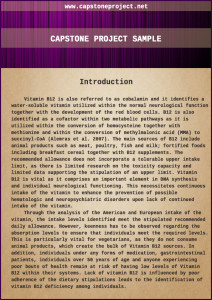Best capstone project examples by expert writers
Our brilliance can only be proven if you see our capstone project examples with your own eyes.
Samples
Figure out the cost of the service supported by rock-solid guarantees.
Our capstone project writers
- Experts with research experience
- PhD/MA degree holders
- At list 4 years in writing
Useful Information About Capstone Project Sample
Whenever you are required to come up with a capstone project, there are certain factors you need to follow to ensure that you are able to present a quality project. It is however not a rare chance to find yourself not understanding what the project demands of you. This is precisely why you will definitely need to find someone to offer some professional help in this field. There are a number of ways in which you might find yourself receiving this help. First of all, you might decide to use the available capstone project sample. This will guide you through the project creation process, from preparing a concept paper for a project to writing the report itself. You may also choose to hire a professional to write you your own customized project which you can submit after performing some changes as your final project. Should you choose to use the available samples, there are a number of issues you need to take into consideration to ensure that your project is in the best quality. We offer you this information so that you can experience a relatively easier time designing your capstone project.
How to Perfectly Use a Capstone Project Sample
You might have one of the best sample projects with you but fail to capitalize on this simply because you do not know how to use it or it doesn’t fit your capstone project nursing, for example. One of the main reasons for using a sample project is so that you can have an idea of what is needed in your project. So the first thing you need to learn from the sample you have is the writing format used to create that sample. Each project has its own designated format and failure to follow the appropriate format may result in submitting a poor quality project which is something you want to avoid by all means. You should, therefore, use the sample to learn on the format you use and make sure to follow that format when writing your project.
Capstone Project Sample
Vitamin B12 is also referred to as cobalamin and it identifies a water-soluble vitamin utilized within the normal neurological function together with the development of the red blood cells. B12 is also identified as a cofactor within two metabolic pathways as it is utilized within the conversion of homocysteine together with methionine and within the conversion of methylmalonic acid (MMA) to succinyl-CoA (Alemras et al. 2007). The main sources of B12 include animal products such as meat, poultry, fish, and milk; fortified foods including breakfast cereal together with B12 supplements. The recommended allowance does not incorporate a tolerable upper intake limit, as there is limited research on the toxicity capacity and limited data supporting the stipulation of an upper limit. Vitamin B12 is vital as it comprises an important element in DNA synthesis and individual neurological functioning. This necessitates the continuous intake of the vitamin to enhance the prevention of possible hematologic and neuropsychiatric disorders upon lack of continued intake of the vitamin.
Through the analysis of the American and European intake of the vitamin, the intake levels identified to meet the stipulated recommended daily allowance. However, keenness has to be observed regarding the absorption levels to ensure that individuals meet the required levels. This is particularly vital for vegetarians, as they do not consume animal products, which create the bulk of Vitamin B12 sources. In addition, individuals under any form of medication, gastrointestinal patients, individuals over 50 years of age and anyone experiencing poor bouts of health remain at risk of having low levels of Vitamin B12 within their systems. Lack of vitamin B12 is influenced by poor adherence of the dietary stipulations leads to the identification of vitamin B12 deficiency among individuals.
Vitamin D is regarded as a unique hormone as it may be produced within the skin through increased exposure to sunlight. Vitamin D is identified in two main forms: D2 and D3. Vitamin D2 is obtained through the UV irradiation of the yeast sterol ergosterol, which is naturally identified within sun-exposed mushrooms. Vitamin D3 synthesis process occurs within the skin and is identified within several oil-rich fish including salmon, mackerel, and herring. It is also available in synthesized form from the cholesterol precursor 7-dehydrocholesterol, which is identified within the skin and may be obtained from lanolin. Vitamin D2 and D3 are utilized in the food fortification process and also within vitamin D supplements. The ingested vitamin D is integrated within chylomicrons that are consequently absorbed within the lymphatic system through the blood. Vitamin D ingested through the skin or diet remains biologically inert, which necessitates hydroxylation within the liver through the use of the vitamin D-25-hydroxylase to 25 (OH) D (3, 8). This necessitates further hydroxylation of 25 (OH) D within the kidneys through the use of 25 (OH)-1-OHase (CYP27B1) to develop a biologically active form of vitamin D 1, 25 (OH)2 D. This enhances the interaction processes with vitamin D nuclear receptor in existence within the small intestine, kidneys together with other tissues within the body. 1, 25 (OH) 2 D influences the absorption of intestinal calcium. This identifies vitamin D as a vital element in the absorption of calcium and phosphorous as a lack of the vitamin would identify 10 to 15% absorption of dietary calcium and 60% absorption of phosphorus. This identifies that vitamin D sufficiency influences calcium and phosphorous absorption by up to 30-40% and 80% respectively. Through increased interactions between 1, 25 (OH) 2 D and the vitamin B receptor within the osteoblast enhance the stimulation of the expression of receptor activator of a nuclear factor-kB ligand. This enhances the interaction with the receptor activator of nuclear factor-kB aimed at inducing immature monocytes to develop into mature osteoclasts that influence the dissolution of the matrix leading to increased production of calcium together with other minerals from the skeleton. The above identifies that the vitamin D receptor remains present within the majority of the tissues and cells within the body thus providing 1, 25 (OH) 2 D with a myriad of biological functions including the inhibition of cellular proliferation and the inducing of terminal differentiation, the inhibition of renin production and the stimulation of macrophage cathelicidin production. The above seeks to identify that vitamin D is vital within the body as it enhances the regulation of cell growth, bone formation, immune function, increased muscle strength, hair growth, fighting off infections and the reduction of risk of autoimmune diseases.
Background and Significance of the Problem
Vitamin B12 deficiency can influence the identification of numerous hematologic and neuropsychiatric disorders, which may, however, be reversed upon the identification of early diagnosis and immediate treatment. However, the exact prevalence levels of vitamin B12 within the general population remain unknown. However, the incidence is identified as increasing with age. A study conducted by Packer et al. (2007) identified that 15% of adults who were older than 65 years projected high deficiencies of vitamin B12. Continued ubiquitous utilization of gastric acid-blocking agents influences the identified decreased levels of vitamin B12, which influence the increased levels of vitamin B12 deficiency realized. Through the analysis of the increasing use of the gents coupled with an increasingly aging population among the developed nations, the actual prevalence of vitamin B12 may be identified higher in comparison to the provided statistics. The common symptoms of B12 deficiency include neuropathic (paresthesia, numbness, and weakness), myelopathic (abnormal gait), cerebral (dementia, depression, memory loss) and in dire cases, the deficiency is identified as hematologic whereby the patient suffers from severe anemia. In addition, vitamin B12 deficiency has been linked to indirect cardiovascular effects. Vitamin B12 deficiency may enhance the production of hyperhomocysteinemia, which identifies a risk factor for atherosclerotic disease. Folic acid supplementation is provided to influence the reduction of homocysteine levels as an avenue utilized in the prevention of coronary artery disease. However, there has been limited emphasis on the role of vitamin B12 deficiency in the development of cardiovascular disease. This possibility is increasingly vital in the consideration of vitamin replacement therapy as folic acid supplementation may hide a growing vitamin B12 deficiency, which will influence the progression of the experienced neurologic disease. This necessitates the determination of vitamin B12 deficiency prior to the initiation of folic acid therapy.
In the human body system, two enzyme reactions remain dependent upon vitamin B12. The first reaction involves the conversion of methylmalonic acid into succinyl-CoA through the utilization of B12 as a cofactor. This identifies that vitamin B12 deficiency may influence the identification of increased levels of serum methylmalonic acid. The second reaction involves the conversion of homocysteine to methionine through the utilization of vitamin B12 together with folic acid as the cofactors. In this reaction, the identification of a deficiency in vitamin B12 or folic acid may influence the identification of increased levels of homocysteine. This necessitates the development of an intricate understanding of vitamin B12’s absorption cycle to provide a better analysis of the potential causes of deficiency. The existence of the acidic environment within the stomach influences the breakdown of B12 identified within the food. Through the release of the intrinsic factor by the parietal cells within the stomach, vitamin B12 remains bound to the duodenum. The intrinsic factor influences the absorption of vitamin B12 within the terminal ileum. There also exists an alternate system of vitamin B12 absorption that does not require the intrinsic factor as influences the binding of vitamin B12 upon absorption to transcobalamin II, which is consequently transported throughout the body. Therefore, interruption of either step places an individual at a high risk of developing a deficiency.
Vitamin D deficiency is characterized by the identification of inadequate provision of minerals to the skeleton. In children, vitamin D deficiency influences the development of rickets, which involves the widening at the end of the long bones, rachitic rosary together with other deformations within the skeleton including outward and inward deformities of the lower limbs leading to the identification of bowed legs and knocked-knees. Among adults, vitamin D deficiency leads to the identification of a mineralization defect within the skeleton leading to the development of osteomalacia. In addition, vitamin D deficiency among adults initiates the mobilization of calcium from the skeleton leading to the development of porotic bone. The identification of a change within the production of vitamin D3 may influence the identification of a vitamin D deficient state. Additionally, the identification of any alterations within the 1, 25 (OH) 2 D within its receptor may influence the identification of vitamin D3 deficiency, which is characterized by metabolic bone disease together with the manifestation of a myriad of biochemical abnormalities. As previously identified vitamin D deficiency influences the identification of a decrease in the levels of ionized calcium within the blood, which influences the identification of an increase in the production and secretion capacity of PTH. PTH influences the mobilization of calcium the skeleton, which enhances the conservation of renal loss of calcium leading to the identification of an increase in the renal excretion of phosphorus. This leads to the identification of normal fasting serum calcium with low-normal serum phosphorous.
Statement of the Problem
Increased deficiency levels of vitamin B12 and vitamin D3 levels within the body necessitate the integration of further research and analysis regarding the importance of conducting regular check up on the existent levels among individuals.
Statement of the Purpose
This study seeks to provide a conclusive analysis regarding the importance of checking the levels of vitamin B12 and vitamin D3 levels within the body. This will be enhanced through the integration of a conclusive analysis of the deficiency levels identified through the analysis of the healthy and unhealthy levels required within the body. This study will incorporate analysis from previous research conducted by several authors within the field, who have provided an analysis of the diagnosis, causes of deficiency and the most preferred follow-up procedure that may be incorporated.
The study will incorporate a literature review section, which will provide an analysis of the importance of checking vitamin B12 and vitamin D3 as conducted by other researchers within the field. This is vital for the study as it will enhance the provision of a wide array of data that will provide conclusive analysis from the past, present and future efforts that may be integrated to limit the levels of deficiency experienced. The study will also incorporate a methodology section, which will outline the data collection methods to be utilized within the study, which provide great relevance and enhance the achievement of the study objectives. This will be followed through the integration of the findings and discussion section, which will provide an analysis of the study and enhance the development of the study recommendations and conclusion.
Review of Literature
The diagnosis of B12 has over time developed its basis upon the analysis of low serum vitamin B12 levels, which are identified at less than 200pg per mL together with the analysis of the available clinical evidence pertaining to the disease. However, the majority of studies identify that older patients present more of neuropsychiatric disease in the absence of hematologic findings. In addition, the provision of measurements of metabolites including methylmalonic acid and homocysteine are identified more sensitive to the diagnosis of vitamin B12 deficiency in comparison to the individual measurement of serum B12 levels. A recent study conducted on 406 patients with vitamin B12 deficiency indicated that 98.4% had elevated serum methylmalonic acid levels with 95.9% identified as having elevated serum homocysteine levels. Only one patient from the 406 had indicated normal levels of both metabolites, which raised the sensitivity level to 99.8% at the period when the methylmalonic acid and homocysteine levels are utilized during the diagnosis. Twenty-eight percent of the patients within the study exhibited normal hematocrit levels with 17% identifying normal mean corpuscular volumes. In a study conducted by Lin et al. (2011) regarding patients with known pernicious anemia who had not been provided with the necessary maintenance levels of vitamin B12 injections for a period spanning several months to years, they exhibited an increase in methylmalonic acid together with decreased levels of hematocrit. The findings from the study identify that methylmalonic acid and homocysteine levels may be utilized as early markers for tissue vitamin B12 prior to the identification of hematologic indications.
Continued utilization of methylmalonic acid and homocysteine levels within the diagnosis of vitamin B12 deficiency has enhanced the provision of varied results. In the event that increased homocysteine or methylmalonic acid levels or through the normalization of the metabolites in response to replacement therapy, they are utilized as diagnostic criteria for vitamin B12 deficiency. The majority of the patients subjected to the process accounting for 50% have identified high levels of serum vitamin B12. This espouses that the utilization of a low serum vitamin B12 level as the main diagnosis may eliminate half of the patients with actual tissue B12 deficiency.
Causes of Vitamin B12 Deficiency
Factors influencing the identification of vitamin B12 deficiency are incorporated into three main categories: nutritional deficiency, malabsorption syndromes together with other gastrointestinal causes.
Nutritional Deficiencies
The main dietary sources for vitamin B12 include meat and dairy products. In a typical diet, an individual derives 5 to 15 mcg of vitamin B12 on a daily basis, which is identified higher than the recommended daily dosage stipulated at 2 mcg. This identifies that the majority of individuals maintain a high vitamin B12 reserve, which has the capability of lasting two to five years. However, nutritional deficiency may be identified within certain populations. For instance, elderly patients who regularly take up tea and toast diets and consume high levels of alcohol are identified as having a higher risk for vitamin B12 deficiency. In addition, the dietary stipulations followed by strict vegetarians place them at high risk of experiencing stipulated deficiency levels.
Malabsorption Syndromes
The main disorder identified within this category is the pernicious anemia, which refers to an autoimmune disease that affects the gastric parietal cells. Therefore, any form of destruction identified among these cells limits the effective production of intrinsic factor, which limits the absorption levels identified regarding vitamin B12. Laboratory evidence incorporated regarding parietal cell antibodies is identified at 85% to 90% sensitive regarding the diagnosis of pernicious anemia. However, the majority of tests identify that the presence of parietal cell antibodies remains nonspecific and occurring within other autoimmune states. The intrinsic factor antibody is identified as being 50% sensitive but is identified as being highly specific for the diagnosis of pernicious anemia. In addition, a Schilling test may be utilized in the development of a distinction among intrinsic factor-related malabsorption in the diagnosis process of pernicious anemia. Schilling test results have been used over time to enhance the determination process regarding whether the patient requires parenteral or oral vitamin B12 supplementation. However, the development of this distinction is rendered unnecessary as the majority of the recent evidence espouses towards the utilization of a B12 absorption pathway that remains independent of intrinsic factors. In addition, several studies have identified that oral replacement is identified equal in efficacy to intramuscular therapy. However, several studies espouse that successful treatment may also be realized through the utilization of oral replacement therapy. This has enhanced the development of several questions regarding the utility of the Schilling test as it is regarded as complicated to perform. This has rendered the identification of vitamin B12 difficult together with increased complexities within the results interpretation process for patients suffering from renal insufficiency. The process of food-bound malabsorption is identified when vitamin B12 bound to protein within food is incapable of being cleaved and released. This is influenced by the integration of any process that provides some level of interference with gastric acid production that may lead to the identification of certain levels of impairment. Atrophic gastritis together with hypochlorhydria is regarded as a major cause among the elderly. In addition, subtotal gastrectomy may influence the identification of vitamin B12 deficiency. Widespread and prolonged use of histamine H2-receptor blockers together with proton pump inhibitors for ulcer disease influence irregular breakdown of vitamin B12 from food leading to increased malabsorption and consequent depletion of B12 levels within the body.
Recent studies espouse that long-term utilization of omeprazole may influence the identification of decreased levels of serum vitamin B12 levels. However, more studies require to be incorporated to enhance the identification of the incidence and prevalence of vitamin B12 deficiency through increased screening for subclinical BB12 deficiency should be enhanced among patients who have experienced long-term acid-suppression therapy.
Other Causes
Patients who have exhibited vitamin B12 deficiency together with chronic gastrointestinal symptoms including dyspepsia, recurrent peptic ulcers or diarrhea necessitate the integration of an evaluation process regarding several factions including Whipple’s disease, which refers to a bacterial infection that limits the absorption levels identified within the body. In addition, the patient may be tested for Zollinger-Ellison syndrome, which influences the development of peptic ulcers and diarrhea. In addition, patients who have had a history of intestinal surgery, strictures or blind lops may identify high levels of bacterial overgrowth, which may limit the provision of the necessary amounts of vitamin B12 within the small bowel together with increased manifestation of tapeworms and other intestinal parasites. In addition, congenital transport-protein deficiency may influence the lack of vitamin B12 leading to the identification of increased deficiency levels.
Vitamin D deficiency
Vitamin D deficiency among adults is described as being endemic. There has been an increasing number in children and adolescents who are identified as being vitamin D deficient. Historically, vitamin D deficiency has been defined as a 25 (OH)D of less than 20 ng/ml. Therefore, vitamin D insufficiency is defined as 25(OH) of 21-29 ng/ml. Through the analysis of the provided definitions, several estimates identify that 20-100% of the American and European elderly men and women within the community exhibit high vitamin D deficiency levels. Vitamin deficiency is identified commonly in Australia, the Middle East, India, Africa, and South America. The deficiency levels are also identified high in the United States as 50% of the Hispanic and African-American adolescents together with 8% of white preadolescent girls exhibited 25 (OH)D below 20 ng/ml. Additionally, 42% of African-American girls and women within the ages of 15 and 49 years identified a blood level of 25 (OH) D below 15 ng/ml. Pregnant and lactating women consuming prenatal vitamins together with calcium supplements with vitamin D are identified as being at high risk for vitamin D deficiency.
Causes of Vitamin D Deficiency
The main source of vitamin D for children and adults remains as increased exposure to sunlight. This is vital as limited foods contain vitamin D. This identifies the main cause for vitamin D deficiency as limited exposure to sunlight. In addition, wearing sunscreen with sun protection limits the level of vitamin D synthesis on the skin by up to 95%. This identifies that individuals with a darker skin tone are provided with natural sun protection hence, they require three to five times longer identifying the same levels of vitamin D as individuals with white skin tone.
There exists an inverse correlation between serum 25 (OH) D and the body mass index (BMI) greater than 20k/m2, which identifies that obese individuals experience vitamin D deficiency. Patients identifying one of the fat malabsorption syndromes together with bariatric patients are identified as challenged in the absorption of fat-soluble vitamin D together with patients with nephrotic syndrome lose 25 (OH) D and remain bound to vitamin D-binding protein within the urine. In addition, patients administering a wide range of medication including anticonvulsant together with antiviral drugs are identified at higher risk as the drugs influence the catabolism of 25 (OH)D and 1,25 (OH)2D. Patients with chronic granuloma-forming disorders including some lymphomas and primary hyperparathyroidism identify high levels of a metabolism at 25 (OH) D to 1, 25 (OH) 2 D are identified at high risk of vitamin D deficiency.
References
Almeras, L., Eyles, D., Benech, P. (2007). Developmental vitamin D deficiency alters brain protein expression in the adult rat: implications for neuropsychiatric disorders. Proteomics,7(5):769-80.
Andres, E., Loukili, N., Noel, E., (2004). Vitamin B12 (cobalamin) deficiency in elderly patients. Can Med Assoc J, 171(3):251-259.
Andres, E., Vidal-Alaball, J., Federici, L. (2007).Clinical aspects of cobalamin deficiency in
elderly patients. Epidemiology, causes, clinical manifestations, and treatment with a special focus on oral cobalamin therapy. Eur J Intern Med, 18:456-462.
Bodnar, M., Simhan, N., Powers, W. (2007). High prevalence of vitamin D insufficiency in black and white pregnant women residing in the northern United States and their neonates. J Nutr, 137(2):447-52.
Duerksen, R., Fallows, G., Bernstein, N. (2006). Vitamin B12 malabsorption in patients with limited ileal resection. Nutrition, 22:1210-1213.
Féron, F., Burne, H., Brown, J. (2005). Developmental vitamin D3 deficiency alters the adult rat brain. Brain Res Bull, 65(2):141-8.
Hvas, M., Nexo, E. (2005). Holotranscobalamin – a first choice assay for diagnosing early vitamin B deficiency? J Intern Med, 2005; 257(3):287-298.
Headstrom, D., Rulyak, J., & Lee, SD. (2008). Prevalence of and risk factors for vitamin B12 deficiency in patients with Crohn’s disease. Inflamm Bowel Dis, 14(2):217-223.
Kwong, C., Carr, D., & Dhalla, A. (2005). Oral vitamin B12 therapy in the primary care setting: a qualitative and quantitative study of patient perspectives. BMC Fam Pract, 6 (8).
Ladhani S, Srinivasan L, Buchanan C, Allgrove J. (2004). Presentation of vitamin D deficiency. Arch Dis Child, 89(8):781-4.
Pajecki, D., Dalcanalle, L., & Souza de Oliveira. (2007). Follow-up of Roux-en-Y gastric bypass patients at 5 or more years postoperatively. Obesity Surgery, 17:601-607.
Rucker D, Allan JA, Fick GH, Hanley DA. (2002). Vitamin D insufficiency in a population of healthy western Canadians. CMAJ, 166(12):1517-24.
Roth De, Martz P, Yeo R. (2005). Are national vitamin D guidelines sufficient to maintain adequate blood levels in children? Can J Public Health, 96(6):443-9.
Ting, Z, Szeto, C, & Chan, H. (2006). Risk factors of vitamin B12 deficiency in patients receiving metformin. Arch Intern Med, 166:1975-1979.
Vidal-Alaball J, Butler CC, Cannings-John, R. (2005). Oral vitamin B12 versus intramuscular vitamin B12 for vitamin B12 deficiency. Cochrane Database Syst Rev, 20;(3): CD004655.
Free Sample Capstone Project Examples: Easy to Follow
Once you have acquired a capstone project example, you should certainly use it as your guide and not your source of information. The example is supposed to act as a blueprint and so you should use in that way. Now there are those who just duplicate the content in the project example and expect to be awarded good grades for their projects. That cannot happen especially so if the professor responsible for marking your projects knows your writing standards, he will certainly recognize that the project you submitted is not actually yours. You should, therefore, learn how to plan your content in the project by using the example and not use it the data in the example.
Here you can watch our capstone project presentation sample. You can order any kind of presentation, and the capstone project writing service experts will do it for you in the best way!
Capstone Project Sample PDF You Need to Download and Try
You will agree with me that you might not have adequate time to write and submit capstone projects within the set deadline. Due to the limited time, you might not have the time to generate English capstone project ideas, learn how to write such a project or research what content is appropriate for that project and its parts. It is during situations like this that you may choose to use a sample project to guide you through the writing process. This will actually save a lot of time which you may use to do something else. The sample project will also eliminate the chances of you making mistakes since you will follow the layout in the capstone paper sample.
The Advantages of Getting Help of Capstone Writing Services
To ensure that your project is unique and original, you should never copy the content in the sample paper. Stick to the tips highlighted above, and you will certainly be able to find great IT capstone project ideas and produce a high-quality project by simply using the available project samples. Another option for writing a great capstone project is capstone writing services. The benefits of using professional capstone writing services are that you will get 100% unique and error-free paper. So if you want to get a paper that out of ordinary and fully customized expert writing assistance is what you need.
We have a team of highly qualified and talented writers who have been working in this industry for years and they ready to provide you with help at the highest standards! The following are some of the advantages of using our capstone writing services:
- Our writers are highly experienced in providing all forms of capstone project help
- We guarantee 100% original writing only
- We offer a wide range of writing services at affordable rates
- We work within your deadline, no matter how tight is it
- The full satisfaction of the final draft is guaranteed





